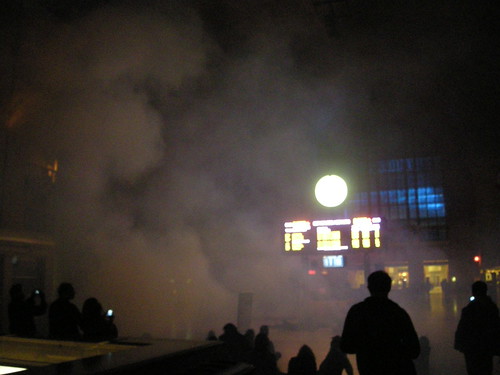
Spacing contributor Carolyn Tripp delved into one of the many installations that took over Toronto last weekend during Nuit Blanche.
– – – – – – – – – – – – – – – – – – – – – – – – –
Modes of transportation typically inform one’s first impression of a city. Historically, Halifax Harbour, the Montreal port, and the Port of Vancouver have been places that have seen immigrants, refugees, and scores of others coming to begin their lives in Canada and North America.
With immigration, there are hellos and goodbyes en masse. Within its walls, Toronto’s Union Station can also boast a similar emotional saga. After its opening 1927, it has seen scores of travelers pass through its doors, both coming and going, staying and unsure of what to do upon arrival.
“Toronto has such a rich history of immigration from so many different countries. Much like New York City, migration has completely informed the social (and literal) construct of the town,” says Heather Nicol of her choice to use the station and it’s past to construct her installation Imminent Departure for this year’s Nuit Blanche. Nicol employed fog machines, dimming lights, and a range of audio tracks for her piece, including sound waves that washed across the station, allowing visitors to actually feel the aural presence of alarm calls and passing trains.
This piece was also informed by Nicol’s personal history as a New Yorker who left her home after September 11th. Imminent Departure doesn’t relate to her experience specifically, but she is particularly moved by the Union’s architecture and capacity to hold a vast amount of comings and goings. Nicol recognizes the ephemeral nature of catastrophe and how it informs the decision to come to a new city and start over.
“When I found that I could use Union Station for Nuit Blanche, it was perfect,” she recalls, “I wanted to the project to not just be about sadness or goodbyes, but the entire emotional spectrum. I didn’t find too many ghost stories about the station specifically, but these sorts of places are haunted. Not in any negative connotation, but perhaps just by their own memoirs.”
Being a fan of architect John M. Lyle and the team behind the station’s design didn’t hurt, either, “I’m a huge fan of what he did with that space. The high ceilings and the detailing make it a perfect train station, and I used the lighting and visual components to move the eye around the building itself. I wanted people to look at the space in as much as I wanted them to stay and listen to the piece.”
Much of the audio, which was spliced with spoken word from several different actors, was loosely based on different influxes of immigrants, decade by decade. “I specifically included English, Greek, Italian, Jamaican, and other nationalities into the verbal portions of the piece. And in spite of increased air travel, Union remains a place that sees so many people arrive at its doors, and just as many that find themselves having to leave or say goodbye.”
There were issues, however, when it came time to include the noise of sirens and alarms, “Relating to my own story, on that day (in September) there were sirens blaring everywhere. Constantly. It was so overwhelming… I thought the piece should definitely include sounds of distress, and therein I found my willingness to make sure they were there. The entire piece needed to evoke of the passage of time, and everything that comes with it.”
Many visitors stayed to feel the resonance wash over them in the station, with fog shooting out from the walls to suggest the passing of a locomotive. Many even lied on the floor beneath the station’s clock, staring at the ceiling to experience the installation.
“I took a break from the sound board and looked over the balcony at the audience. I just loved how many people were down there. It’s always uplifting to see the Nuit Blanche crowd respond that way. It’s a wonderful night to be a part of.”
Unlike some installations that are a graft on top of a building or structure, Nicol’s use of the space informed the viewers rather than entertained at them. Within the piece lay the ambient groundwork for understanding a city’s past, and finally, as a result, made the walls talk.
photo by Neal Jennings

3 comments
Easily one of the best from this year’s Nuit Blanche.
It was also fun watching the “actual travellers” enter Toronto with their suitcases to such a spectacle. A similar event could be seen at the Toronto Coach Terminal where travellers could be seen scratching their heads in disbelief at a boxing ring in the middle of the bus terminal!
“Welcome to the big city” is what I thought to myself.
Nicol’s wonderful installation did so well what many similar appropriations of civic architectural space fail to do: it helped us re-consider the building and its context on its own terms, rather than as simply a structure to be utilized and disrupted as part of an artist’s own subjective agenda and goals.
The sight of hundreds of people lying on the cool marble floor of the Station and gazing up at the magnificent arched ceiling with fresh eyes, while simultaneously awash in the splendid and mysterious sea of imagined and historical voices assembled on the multi-channel soundscape was spine-tingling.
I myself think that this year edition should have been called “Nuit Blah”….